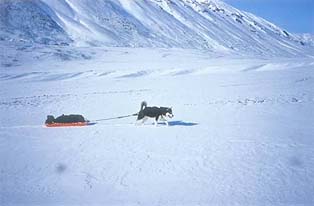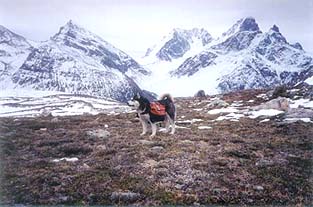
Tuk accompanied me on my 700 km. solo expedition across Ellesmere Island. Although he was only a year old, he was already close to 100 lbs. Not wanting to over work him, he pulled his own sled weighing approximately 110 lbs. He appeared to hardly notice the weight judging by the number of seals he raced after. It was quite apparent that he was bred for Arctic travel. Thousands of years of evolution created a dog that would work all day in frigid temperatures and then bed down in the worst gale at night, all the while keeping an eye out for polar bears. Tuk, of Kokamal Kennels is my first Malamute. Having gone through a number of different breeds in the past, I found most other dogs cannot hold up to the rigors of mountain life. The Arctic is challenging, but the northern Rockies of Alberta push a dog to his limits. Now at eighteen months old and 110 lbs, Tuk is turning into an excellent pack dog. His big boned frame and heavily muscled body can take the pounding incurred while climbing mountains, negotiating his way through heavy timber, and bull dozing his way down avalanche slopes. He shows little fear at high elevations and handles steep grades and precarious ledges like a mountain goat. Tuk willingly crosses fast flowing rivers with his pack on, and at age four months I almost lost him after he boldly jumped into the Moose River in Robson Park and was swept downstream. He is also an excellent watch dog at night and has twice alerted me to grizzly bears in the vicinity, one having entered our camp after dark. Tuk, then aged six months, stood his ground which allowed me time to retrieve my bear banger and hence scare it off. Tuk works like a Trojan, hiking his pack up mountainsides in six to seven feet of snow or pulling his sled through deep powder. He is the ultimate trooper, never shying away from hard work. On one leg of my Ellesmere trip, I had traveled eight hours overland through extremely deep snow. Breaking trail for Tuk, he struggled along behind me for eight hours. At the end of the day, I would drop the gear and head off for another two hours on a 'route finding' quest. Inevitably, Tuk would quickly recuperate and join me somewhere along the trail for two more hours of travel. If there is any question as to the genealogy of this breed, Tuk adopted an Arctic wolf on my last expedition. They got along very well and spent time playing, jostling, and at one point got into a struggle until I broke it up. They eventually parted ways when we pushed onwards, with Tuk having resumed his canine duties pulling his sled, and the wolf heading off after prey. Overall, Tuk rates superior in all areas of outdoor activity. He has an even temperament and is exceptionally friendly to other people. Unfortunately this past weekend on a three day trip into the mountains, Tuk ran into a porcupine. Characteristic of northern breeds, he would not let me get near his mouth and after unsuccessful attempts, pliers in hand to get the quills out, we hiked out at three a.m. down the mountain side, to ultimately end up at the vets who in turn put Tuk under to remove the quills. I look forward to many more years of travel with Tuk and have no doubt that in any altercation with either a polar or grizzly bear, he would stand his ground and protect me. For our next expedition we are looking at travelling to Alaska, along the north slope of the Brooks range and plan to cross over into territory where Tuk's kind evolved. I'm quite impressed with the Malamutes from Kokamal Kennels, so much so that in the future I would ultimately like to obtain a female from this particular breeder. by Garry Last, Brule, Alberta
|

